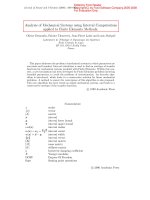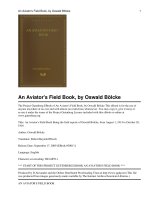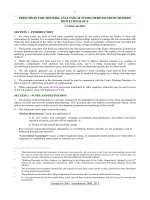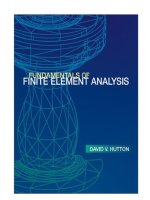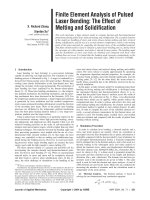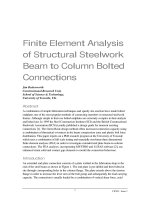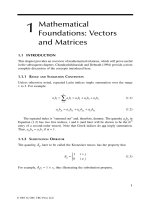An integrated finite element analysis of CFRP laminates from low velocity impact to CAI strength prediction
Bạn đang xem bản rút gọn của tài liệu. Xem và tải ngay bản đầy đủ của tài liệu tại đây (7.34 MB, 223 trang )
AN INTEGRATED FINITE ELEMENT ANALYSIS OF
CFRP LAMINATES: FROM LOW-VELOCITY IMPACT
TO CAI STRENGTH PREDICTION
CHRISTABELLE LI SIXUAN
B.Eng. (Hons.), NUS
A THESIS SUBMITTED
FOR THE DEGREE OF DOCTOR OF PHILOSOPHY
DEPARTMENT OF MECHANICAL ENGINEERING
NATIONAL UNIVERSITY OF SINGAPORE
2013
i
DECLARATION
I hereby declare that the thesis is my original work and it has been
written by me in its entirety. I have duly acknowledged all the sources of
information which have been used in the thesis.
This thesis has also not been submitted for any degree in any university
previously.
Christabelle Li Sixuan
30 May 2013
ii
ACKNOWLEDGEMENTS
Apart from Jesus, I can do nothing; yet I can do all things through Christ who
strengthens me. (John 15:5, Philippians 4:13)
It has been my privilege and honor to be under the supervision of Prof. Tay Tong
Earn throughout the course of my research. While knowledge is the prerequisite to
being a professor, Prof. Tay has been one professor who is not only knowledgeable
but who also abounds in wisdom, and I have gained a lot from him. Despite his busy
schedule, he always has time for his students.
I would also like to extend my gratitude to the post docs and research students in
the lab, particularly Ridha, Boyang and Zhou Cheng. I have the propensity for asking
stupid questions, and they have the patience to hold countless discussions with me.
This research would not have been possible without their help.
To my granddad-You were the one who taught a little girl that she could dream big
dreams.
To my parents, especially my mum-Everyone needs someone who believes in them
even when they stop believing in themselves, someone who understands them
more than they could ever understand themselves, someone who encourages them
in anything they choose to undertake, someone who loves them even when they’re
most unlovable. I’m blessed to have found that someone in you.
From one belle to the other-You’re the ding to my dong. How could I have kept my
sanity without having a sister to go crazy with and to laugh with, like we had not a
care in the world?
To Benaiah-You are to me a great encourager, a constant support, a reliable
companion, my best friend. Thank you for the patience and understanding you’ve
extended to me throughout the years of research and months of thesis writing. I
would not have been able to complete this thesis without you and the humor that
you inject into every situation.
iii
CONTENTS
ACKNOWLEDGEMENTS ii
PRESENTATION v
SUMMARY vi
LIST OF FIGURES ix
LIST OF TABLES xvi
LIST OF SYMBOLS xvii
CHAPTER 1 INTRODUCTION 1
1.1 Objectives of study 4
1.2 Chapters overview 5
CHAPTER 2 BACKGROUND OF RESEARCH AND LITERATURE REVIEW 7
2.1 Background 8
2.1.1 Fiber-Reinforced Composites 8
2.1.2 Low-Velocity Impact 12
2.1.3 Low-velocity impact damage mechanisms 14
2.2 Literature Review 21
2.2.1 Studies on low-velocity impact damage 22
2.2.2 Studies on compression after impact (CAI) strength 34
2.3 Review of failure criteria used in this study 39
2.4 Review of damage modeling techniques used in this study 44
2.4.1 In-plane damage modeling techniques 44
2.4.2 Delamination modeling techniques 50
2.5 Brief review of types of elements, implicit and explicit analyses and
non-linear analyses [146] 52
2.6 Conclusion 56
CHAPTER 3 FINITE ELEMENT MODEL 57
3.1 Modeling strategy 58
3.1.1 In-plane damage modeling 58
3.1.2 Delamination modeling 66
3.1.3 Control of finite element instabilities 68
3.2 Development of FE model 70
iv
3.3 Conclusions 83
Chapter 4FINITE ELEMENT SIMULATIONS OF LOW-VELOCITY IMPACT 84
4.1 Verification of FE model for low-velocity impact 85
4.1.1 Cross-Ply laminate of layup [0
o
2
/90
o
6
/0
o
2
] 85
4.1.2 16-ply quasi-isotropic laminate of layup [-45
o
/0
o
/45
o
/90
o
]
2s
. 89
4.1.3 16-ply quasi-isotropic laminate of layup [0
o
2
/45
o
2
/90
o
2
/-45
o
2
]
s
104
4.2 FE study of low-velocity impact on a [0
o
/45
o
/90
o
/-45
o
]
s
laminate
(Reference case- Model A) 109
4.3 Parametric studies 116
4.3.1 Thin-ply effect 117
4.3.2 Surface-ply effect 121
4.3.3 Effect of laminate thickness 124
4.3.4 Effect of ply-grouping 124
4.3.5 Effect of relative angle between fiber orientations of adjacent
plies 127
4.4 Conclusions 129
Chapter 5 FINITE ELEMENT SIMULATIONS OF CAI TESTS 132
5.1 Finite element models of CAI tests 133
5.1.1 Uniform delamination models without matrix cracks 143
5.1.2 Non-uniform delamination model without matrix cracks 146
5.1.3 Uniform delamination model with matrix cracks 152
5.1.4 Non-uniform delamination model with matrix cracks 155
5.2 Parametric studies 167
5.3 Conclusion 171
Chapter 6 INTEGRATED FE ANALYSIS FROM LOW-VELOCITY IMPACT TO
CAI STRENGTH PREDICTION 173
6.1 Description of integrated FE analysis 175
6.2 Results and discussions 179
6.3 Conclusions 185
Chapter 7 CONCLUSIONS AND RECOMMENDATIONS FOR FUTURE WORK
187
7.1 Conclusions 188
7.2 Recommendations and future work 190
v
PRESENTATION
Composites Durability Workshop (CDW-15)
Kanazawa Institute Technology, Kanazawa Japan
October 17-20, 2010
vi
SUMMARY
Carbon fiber-reinforced plastic (CFRP) laminates have gained
increasing usage especially in the aerospace industry due to its high
strength and stiffness, coupled with its lightweight properties. In the
1980s, only 3% by weight of the Boeing 767 was made of CFRP. Today,
this percentage has increased to 50% in the Boeing 787. Some modern
military aircrafts contain 70% by weight of CFRP.
In the assessment of damage tolerance of a composite structure,
the most critical source of damage has to be considered. Low-velocity
impact that could be caused by dropped tools or runway debris has been
found to be the most critical source of damage in composite laminates due
to a lack of fiber reinforcement in the out-of-plane direction. Low-velocity
impact loading is considered to be potentially dangerous because it
causes Barely Visible Impact Damage (BVID) on composite materials such
as embedded matrix cracks, delaminations and fiber failure. Such impact
damage has been found to affect the residual compressive strength to the
greatest extent due to buckling in the delaminated areas. As such,
Compression After Impact (CAI) strength is of particular concern, and is
adopted by industries to be an important measure of damage tolerance of
composite materials.
Extensive experimental research has been performed on the topic
of low-velocity impact of CFRP laminates and its consequent CAI strength.
Industries have also integrated FE simulation into part of their design
process in order to minimize design costs and to achieve higher efficiency,
thereby promoting extensive Finite Element (FE) analyses that have been
performed to study the damage pattern on CFRP laminates arising from
low-velocity impact, and to predict the CAI strength of impact damaged
composites. The impact event and CAI test are two separate topics, often
studied separately. In FE simulation models aimed at predicting the
vii
resultant CAI strength due to low-velocity impact damage, a very
approximate damage is usually pre-modeled into the FE model, neglecting
matrix cracks and fiber failure. However, experimental studies have
shown that the reduction in compressive strength due to impact damage
is caused not solely by delaminations, but a complex interaction of matrix
cracks, fiber breakage and delaminations. It is hence evident that there
still exists a gap between experimental findings and the current capability
of accurately emulating the findings in a computational model.
With the purpose of bridging this existing gap, the overarching aim
of this research is to devise an integrated FE simulation for the prediction
of impact damage initiation and progression due to low-velocity impact
and subsequently predict the residual CAI strength using the same
damaged model. Such an integrated approach has the potential to be
developed into a convenient design tool into which design engineers can
input both the impact and composite plate parameters, and obtain the CAI
strength value.
This research is conducted in three stages:
Stage
Objectives
I: Low-velocity
impact
To build a finite element model for the prediction of impact
damage initiation and progression. The finite element model is
validated by comparison with experimental results obtained from
literature.
II: CAI test
To build a finite element model with pre-included damage
(including both delaminations and matrix cracks) for the
prediction of residual CAI strength from a given damage pattern.
III: Integrated
approach
To integrate stages I and II into a single FE simulation such that
CAI strength can be predicted directly from the impact damaged
model, without having to pre-include an approximate damage for
the purpose of CAI strength prediction.
viii
Overview of Research
Figure 1 Overview of research
ix
LIST OF FIGURES
Figure 1 Overview of research viii
Figure 2 Impact energy of dropped tools [22] 9
Figure 3 Comparisons of tensile strength obtained from unidirectional tensile
tests of aluminum alloy and CFRP laminates in three different loading
directions- S, L and T, as depicted in the figure [22] 10
Figure 4 3D representation of damage mechanisms 15
Figure 5 2D representation of damage mechanisms 15
Figure 6 Matrix cracks development in (a) flexible and (b) rigid structures
[18] 18
Figure 7 (a) Delamination formation mechanism and (b) interface tension
stress zones, obtained from [41] 20
Figure 8 Delaminations in the impacted plates: (a) [0
4
/90
4
], (b) [0
4
/75
4
] , (c)
[0
4
/60
4
] , (d) [0
4
/45
4
] , (e) [0
4
/30
4
] , (f) [0
4
/15
4
], obtained from [36].
Impact direction is into the plane of the paper. 25
Figure 9 Delamination lengths and widths in plates subjected to static loads
as functions of the total number of plies N in the plate, with plate
dimensions 3in by 4in (1in=25.4mm), obtained from [58] 27
Figure 10 Geometry and boundary conditions for the simulation of an impact
event on a 24-ply laminate, with only half the structure represented,
obtained from [64] 31
x
Figure 11 Ply delaminations at each interface of the impacted composite
panel, obtained from [66] 33
Figure 12 Delamination (a) closes up under tension and (b) buckles locally
under compression 34
Figure 13 Example of an element loaded in tension up to final fracture 61
Figure 14 Linear softening applied to simulate material degradation 62
Figure 15 Zig-zag approximation of the linear softening law for in-plane
material stiffness degradation [148] 69
Figure 16 Fiber orientations 70
Figure 17 (a) x-z view of the impact FE model, (b) Magnified x-z view,
showing the ply and cohesive numbering and dimensions, (c) x-y view
and (d) isometric view 72
Figure 18 Low-velocity impact damage prediction for a [0/45/90/-45]s
laminate obtained from (a) Mesh 1 (composed of uniform elements-the
mesh is too dense to see the individual elements clearly), (b) Mesh 2
(composed of smaller elements around the point of impact and larger
elements towards the edge of the laminate) and (c) Partial cohesive
model 79
Figure 19 (a) x-y view of the part without cohesive interfaces 80
Figure 20 Low-velocity impact damage prediction for a [0/45/90/-45]s
laminate with (a) immediate degradation and (b) gradual degradation
according to the linear law in Figure 21 81
Figure 21 (a) Immediate stress degradation to zero after damage initiation (b)
Linear softening law simulating damage progression 81
xi
Figure 22 Damage in a [0
o
2
/90
o
6
/0
o
2
] cross-ply laminate under low-velocity
impact 86
Figure 23 Damage prediction in a [0
o
2
/90
o
6
/0
o
2
] cross-ply laminate under
low-velocity impact 87
Figure 24 (a) Experimental set up for low-velocity impact test (b)
Dimensions of CFRP laminate (c) Magnified x-z view showing sequence
of layup. Pictures are obtained from [3] 90
Figure 25 Boundary conditions imposed on FE model 92
Figure 26 Methodology of 3D characterization of impact damage in laminate,
obtained from [3] 94
Figure 27 Damage distribution image for the impacted [-45/0/45/90]
2s
laminate obtained from the 3D damage characterization method
illustrated in Figure 26 [3] 95
Figure 28 Detailed delamination distribution map for the impacted
[-45/0/45/90]
2s
laminate. Only half the specimen is shown because the
delamination is rotationally symmetrical about the line passing through
the impact point in the z-axis direction. [3] Opposite numbering of ply is
shown here because such a numbering system is used by the researchers
who conducted the experiment. 96
Figure 29 Fiber orientations for the experiment conducted by Kimpara et al.
[3] 97
Figure 30 Delamination profile obtained from experiments. (a) Delamination
profile provided by I. Kimpara and H. Saito. [3] (b) Delamination profile
as intepreted in current thesis, showing the lengths of the delaminations.
100
xii
Figure 31(a) Low-velocity impact delaminations on a [-45
o
/0
o
/45
o
/90
o
]
2s
laminate predicted by the FE model, showing the lengths of the
delaminations 102
Figure 32 Experimental and modeling delamination in the impacted and non-
impacted side, obtained from [41] 105
Figure 33 (b) A detailed comparison of the delaminations observed in an
experiment with the delaminations predicted by the FE model 107
Figure 34(a) FE prediction of impact damage in composite plies from Model
A 110
Figure 35 Impact damage occurring at Ply 1 and Interface 1, captured at
different impactor displacement increments to demonstrate the
relationship between matrix cracks and delamination sizes 113
Figure 36 Pictorial representation of impact damage sequence in a
[0/45/90/-45]
s
layup. Red represents the increments at which matrix
crack initiation and growth occurs, yellow represents the increments at
which delamination initiation and growth occurs 113
Figure 37(b) Comparison of impact damage predicted by FE models with and
without the inclusion of pre-cracks, [0/45/90/-45]
s
114
Figure 38 FE prediction of impact damage from Model B 118
Figure 39 FE prediction of impact damage from Model A and Model C 122
Figure 40 FE prediction of impact damage from Model A and Model D 123
Figure 41 Impact damage prediction of Model D and Model E 126
Figure 42 Impact damage prediction for [0/10
2
/0] layup 128
xiii
Figure 43 FE model for the prediction of CAI strength. The mesh is not shown
in this figure because different meshes are used for this study, and the
different meshes are shown in the later part of this chapter. 135
Figure 44 Pictorial representation of constraints used in the FE model to
prevent the interpenetration of surfaces 136
Figure 45 CAI test experimental set-up, obtained from [3] 138
Figure 46 Experimental comparison of the residual CAI strength with
compressive strength of an undamaged specimen, obtained from [3] . 139
Figure 47 Pictorial representation of how matrix cracks are modeled 143
Figure 48 Uniform delamination models with (a) through-width
delaminations and (b) embedded square delaminations 144
Figure 49 Mesh used for Models A, B, C1, C2 and D 144
Figure 50 Buckled shape for Model A 145
Figure 51 y-z view of buckled shape for Model B, with magnification of 20
times in the z direction 145
Figure 52 Pictorial representation of how delaminations are modeled in
Model D 148
Figure 53 Pictorial representation of how delaminations are modeled in
Models E1 and E2. 149
Figure 54 Modeling of spiral shaped delaminations progressing at 45
o
units
as observed in the reference experiment in Models E1and E2 150
Figure 55 Buckled shape for undamaged model. The same buckled shape is
obtained from Models D and E1. 152
xiv
Figure 56 Delaminations located in the shaded region in the center of the
composite plates, with (a) horizontal 0
o
matrix cracks (yellow) and (b)
vertical 90
o
matrix cracks 152
Figure 57 FE results obtained for (a) Model C2 and (b) Model C1 154
Figure 58(a) Pictorial representation of matrix crack modeling. The red lines
represent the cracks, where the nodes are not merged. 155
Figure 59(b) Experimental results obtained from [3]. Cross sections provide
matrix cracks and delamination damage information 159
Figure 60 Representation of matrix cracks in yellow 161
Figure 61 Example of the approximation of delamination (red) and matrix
crack (yellow) size and position from experimental result into Model E2
162
Figure 62 Stress-strain curve comparing experimental results to FE results
162
Figure 63 y-z view of buckled Model E2, with each composite ply removed
successfully to reveal the buckled shape of each composite ply 163
Figure 64 Composite Ply 3 of Model E2, showing that the 45
o
crack pre-
modeled allows for the lateral deflection of the ply under compression
164
Figure 65 Cut view of the FE results from Model E2, showing that
interpenetration of the composite plies does not occur 165
Figure 66 Summary of the nine cases considered in the parametric study . 167
Figure 67 Stress- strain curve from parametric study, showing the CAI
strengths for models with medium and small delaminations 169
xv
Figure 68 Stress-strain curve from parametric study, showing the CAI
strengths for models with large delaminations 169
Figure 69 Steps in the integrated FE analysis 175
Figure 70 Force-displacement curve for impact on a [-45/90/45/0]
2s
laminate 178
Figure 71 Stress-strain curve comparing the CAI strength predicted using the
integrated FE approach with that predicted using the CAI strength
prediction model with pre-modeled delaminations and cracks 180
xvi
LIST OF TABLES
Table 1 Degradation scheme employed by Tserpes et. al. [122]in the
modeling of progressive damage 48
Table 2 Material properties of composite plies 74
Table 3 Material properties of cohesive elements 75
Table 4 Total CPU time required to complete a low-velocity impact
simulation on a 16 ply laminate with [0/45/90/-45]2s layup 78
Table 5 Summary of the specifications of 7 different FE models used in the
parametric studies 117
Table 6 Different FE models for CAI strength prediction used in this study. All
models have the same stacking sequence as the laminate used in the
reference experiment except Models C1 and C2 142
Table 7 Summary of CAI predicted in the parametric study 168
xvii
LIST OF SYMBOLS
E
1
, E
2
, E
3
Young’s moduli
G
12
, G
13
, G
23
Shear moduli
In-plane fracture toughness in fiber direction under tension
In-plane fracture toughness in fiber direction under
compression
Mixed-mode fracture energy
Mode I critical fracture energy
Mode II critical fracture energy
,
,
Cohesive elements stiffnesses
N
Normal strength of cohesive elements
S
Shear strength of cohesive elements
,
,
,
Shear strength
T
Effective traction of cohesive elements
Original thickness of cohesive elements
Compressive strength in the fiber direction
Tensile strength in the fiber direction
Compressive strength in the transverse direction
Tensile strength in the transverse direction
Degradation factor for fiber dominated damage
Degradation factor for matrix dominated damage
xviii
Instantaneous values of the degradation factors
,
,
Displacement components for cohesive elements
Strain components
Effective strain
Strain at onset of failure
Strain at final failure
,
Strain components of cohesive elements
l
c
Characteristic length of an element
Material parameter in the B-K criterion
Stress components
Effective stress
t
n
Normal traction for cohesive elements
t
s
, t
t
Shear tractions for cohesive elements
v
12,
v
13,
v
23
Poisson’s ratios
1
CHAPTER 1
INTRODUCTION
Carbon Fiber Reinforced Plastics (CFRP) have found increasing
applications in light-weight structural members, in fields of aerospace,
automobile and marine due to their high performance index such as their
high strength-to-weight and stiffness-to-weight ratios. CFRPs are
significantly lighter than aluminum, yet they can be as strong and as stiff as
steel. However, the damage mechanisms of FRP are still not very well
understood.
The main inhibiting factor that prevents the use of CFRPs from being
more prevalent in industries is its susceptibility to impact damage due to
low-velocity impact. The likelihood at which the body of an aircraft is
exposed to low-velocity impact is very high, because low-velocity impact can
be caused by seemingly trivial events such as the dropping of tools on the
body of the aircraft during maintenance or by the impact of runway debris
during takeoff or landing. Barely visible impact damage (BVID) arising from
the low-velocity impact of CFRPs, namely matrix cracks, fiber breakage and
delaminations interact with each other, leading to the complex nature of
damage mechanisms in CFRP. It is known that BVID will cause a significant
reduction in compressive strength of the composite [1, 2]. Industries have
thus adopted compression after impact (CAI) strength as a consideration in
designing composite structures. With the increasing popularity of CFRP in
industries, it is imperative that we predict the CAI strength of impact
damaged composites as accurately as possible.
2
Many experimental studies have been performed over the years with
the common goal of better understanding the impact and CAI behavior of
FRP [3-8]. These experimental studies have formed the basis of our current
understanding of impact behavior, including the impact-damage
characterization and the resulting impact-induced reduction of compressive
strength. It is from this basis that numerical, analytical and finite element
analyses are formulated with the aim of CAI strength prediction [2, 9-11].
Industries have integrated simulation into part of their design process
in order to minimize design costs and to achieve higher efficiency, thereby
promoting extensive studies that have been performed to better predict the
CAI strength of impact damaged composites. These studies have contributed
to the knowledge base of CAI strength prediction. The difficulty in modeling
low-velocity impact on composite plates and its residual CAI strength
prediction arises from the complexities of low-velocity impact damage. For
the same incident energy, different combinations of impactor mass and
velocities can have different effects on the impact response [12].
Furthermore, different sizes and layups of the composite plates would
display different damage patterns. The differences in damage patterns in
turn lead to differing residual compressive strength, or CAI strength.
To the author’s knowledge, there is currently no CAI strength
prediction model that allows for the user to obtain a predicted CAI strength
value by specifying the impact energy, together with the composite laminate
parameters and boundary conditions. In most CAI strength prediction
models, the impact damage as observed from impact tests has to be manually
included into the model. Through such a process, some damage details are
inevitably lost. For example, in most CAI strength prediction efforts, only
delaminations are modeled. Delamination growth is assumed to be the sole
cause of compressive strength reduction on the account that delamination is
the dominant damage mode causing compressive failure [10, 13-15].
3
Furthermore, the delaminations modeled are generally assumed to take on
simple circular or elliptical shapes. However, it has been found through
experimental studies that the reduction of compressive strength due to
impact damage is not caused solely by delamination, but by a complex
interaction of matrix cracks, fiber breakage and delamination [16-20].
Studies investigating the interaction between the different damage modes
resulting from impact are also relatively scarce.
4
1.1 Objectives of study
Although extensive experimental results exist to contribute to our
current understanding of low-velocity impact damage and CAI behavior,
there still exists a gap between experimental findings and the current
capability of accurately emulating the experimental findings in a
computational model.
With the motive of bridging this existing gap, the overarching aim of
this research is to devise an integrated FE simulation for the prediction of
impact damage initiation and progression due to low-velocity impact and
subsequently predict the residual CAI strength using the same damaged
model. The main rationale guiding this research is to avoid over-
simplification of the finite element models such that the predictions obtained
are inaccurate, yet also to avoid having to model to an impractical and
excessive level of accuracy such that the method loses its efficiency.
With this main objective in mind, the research is broken down into
three stages, each stage bearing its own objective leading towards the main
objective:
Stage
Objectives
I: Low-
velocity
impact
To build a finite element model for the prediction of impact
damage initiation and progression. The finite element model will
be validated by comparison of the FE results with experimental
results obtained from literature.
An FE model capable of accurately predicting the impact damage
sequence and extent of damage for different impact and
composite laminate parameters is crucial for the accurate
prediction of residual CAI strength.
II: CAI test
To build a finite element model with pre-included damage
(including both delaminations and matrix cracks) for the
prediction of residual CAI strength from a given damage pattern.
III:
Integrated
approach
To integrate stages I and II into a single FE simulation such that
CAI strength can be predicted directly from the impact damaged
model, without having to pre-include an approximate damage for
the purpose of CAI strength prediction
5
1.2 Chapters overview
Chapter 2 of this thesis covers the background knowledge required in
this research, including the definitions of low-velocity impact and BVID,
impact damage mechanisms of CFRP, and a literature review of selected
studies relating to low-velocity impact and CAI strength prediction. Chapter 3
details the finite element model formulated for this research. The chapter
starts with a brief review of selected failure criteria and damage modeling
techniques available, followed by a description of the modeling strategy
adopted in the finite element model formulation of this research.
Chapter 4 presents stage I of the research, where the finite element
model is used to simulate low-velocity impact and to study low velocity
impact damage initiation and progression. The purpose of this stage of the
research is to predict the impact damage sequence and the locations, sizes
and shapes of delaminations, matrix cracks and fiber failure as observed in
experiments to an acceptable accuracy. Additionally, results from the various
parametric studies conducted to investigate the influence of parameters such
as ply thickness and ply angle variation on impact damage are presented in
this chapter.
Chapter 5 presents stage II of the research, where damage due to low-
velocity impact is approximately pre-modeled into the finite element model
for the prediction of residual CAI strength. In this study, a combination of two
different damage modes, namely matrix cracks and delaminations were
included, and different damage shapes, sizes and locations were pre-modeled
into the finite element model. The purpose of this stage of the research is to
determine the dominant damage modes that have an influence on the
residual CAI strength. To confirm the efficacy of this modeling technique,
damage patterns of an impacted composite plate as observed from an
experimental study were also modeled into the finite element model, and the
6
residual strength obtained from the finite element simulation was compared
with the experimental value.
Chapter 6 details the integrated approach in which CAI strength is
predicted using the exact damage information obtained from the finite
element simulations of low-velocity impact. Finally, chapter 7 presents the
conclusions of the research and recommendations for future direction of
research.
